News
The reuse of treated waste water
Alera european project
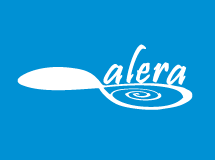 On the 29th and 30th of april 2015 took place the first meeting around the european project Alera destinated to highlight, via a dedicated web site, the reuse actions of the treated waste waters throughout the Pyrenees-Mediterranean euro region. The Granollers district (Spain), who brings the project, organised these two days of exchanges between the members of a work group composed of representatives of the Polytechnic University of Catalonia, the Migjorn Gran (Spain) town council, the consulting firm Ecofilae (France), and the CCTVA. This meeting started by a quick general survey of the international practices regarding the treated waste waters reuse (REUSE). So Spain reuses almost 570000 m3 of water each year, while France reuses only 24000 m3. These last years several projects of water reuse were setted up in Catalonia, in particular in Granollers which cleans the streets and waters the public green spaces with the used water coming from the water treatment plant.
On the 29th and 30th of april 2015 took place the first meeting around the european project Alera destinated to highlight, via a dedicated web site, the reuse actions of the treated waste waters throughout the Pyrenees-Mediterranean euro region. The Granollers district (Spain), who brings the project, organised these two days of exchanges between the members of a work group composed of representatives of the Polytechnic University of Catalonia, the Migjorn Gran (Spain) town council, the consulting firm Ecofilae (France), and the CCTVA. This meeting started by a quick general survey of the international practices regarding the treated waste waters reuse (REUSE). So Spain reuses almost 570000 m3 of water each year, while France reuses only 24000 m3. These last years several projects of water reuse were setted up in Catalonia, in particular in Granollers which cleans the streets and waters the public green spaces with the used water coming from the water treatment plant.
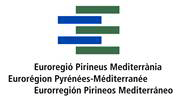
In France, the REUSE is limited to the green spaces watering and the agricultural irrigation. Moreover, it is why the septage sludge treatment plant of Negrepelisse irrigates a 3,2 hectares forest plot since 2014. The exchanges continued with a presentation of the projects of each members, and then concetrated on the content and the form of the informations that will be on-line. The second day was devoted to a technical visit of three reused treated water installations, respectively situated on the districts of Sabadell, Granollers and Sant Cugat.
The next meetings will take place in Spain in the course of october 2015, then in France in the course of april 2016.
Septage Sludge Treatment
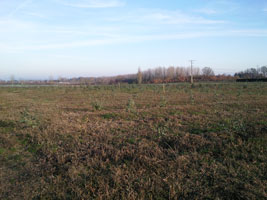 The creation of a septage sludge treatment unit in the north east of the department is a project of the Tarn and Garonne Waste Local Union, and whose purpose is to fill in the too little number of plants and to reduce the illegal practices as fly-tipping.
The creation of a septage sludge treatment unit in the north east of the department is a project of the Tarn and Garonne Waste Local Union, and whose purpose is to fill in the too little number of plants and to reduce the illegal practices as fly-tipping.
This project began in 2010 by a project engineer’s selection and the choice of an alternative treatment to the chemical process. The contracting authority choosed the constructed wetland treatment technique, and the development of the treated waters. The choice of the firms was done during the summer 2011.
Epur Nature was retained for its project of the septage sludge treatment on two layers of filtration. As the contracting authority wanted, the treated waters are directed according to the period of the year, or to the Short Rotation Coppice which supplies Negrepelisse’s wood heating system (summer functioning), or to the existing ponds before the disposal in the receiving water (Winter functioning).
View a treatment steps for each season (summer & winter)
The irrigation project will be studied in January 2012 by the Local Committee for the Environment and the Sanitary and Technological Risks, regarding the decree of January 8th 1998. The project should be realized during the first trimester of 2012.
The Water in Nègrepelisse
The city of Nègrepelisse is laid on the reaches of the Aveyron river. Its history is linked to the water and its inhabitants concerned in the preservation of this living heritage.
The confluent of the Longues-Aygues creek and of the Aveyron river
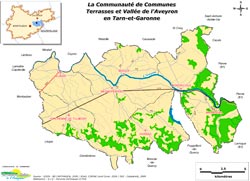 The city of Nègrepelisse is marked from its creation, probably in the Roman period, by its relation to the water:
The city of Nègrepelisse is marked from its creation, probably in the Roman period, by its relation to the water:
« A praesidium had been constructed on the northern edge of the ancient forest of Tulmon, in the strong position which gives the confluent of the stream of Longues-Aygues and of the Aveyron.»
The city is established in a meander of the Aveyron and the river is an important element of the landscape and of the patrimony, carefully preserved by the inhabitants, among others through the quality of wastewater discharges into the river...
Three major steps mark this concern for the impact of human activity:
- 1982: construction of the treatment ponds - 1400 PE
- 2008: construction of the CW treatment plant - 4000/6000 PE
- 2011: construction of a septage treatment plant serving the north-eastern part of the Department.
The plain of the Aveyron river
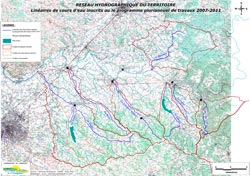 The plain is drained, in the sector of Nègrepelisse, by a network of small creeks. Nègrepelisse’s wastewater is discharged, since creation of the ponds in 1982 and after treatment of course, to the Montrosies creek, affluent of Courounets creek, affluent of the Aveyron river. Between its discharge from the treatment plant and its arrival in the Aveyron, they follow successively:
The plain is drained, in the sector of Nègrepelisse, by a network of small creeks. Nègrepelisse’s wastewater is discharged, since creation of the ponds in 1982 and after treatment of course, to the Montrosies creek, affluent of Courounets creek, affluent of the Aveyron river. Between its discharge from the treatment plant and its arrival in the Aveyron, they follow successively:
- the Montrosies creek on 0.5 km
- the Courounets creek on 3.0 km.
The Montrosies and Courounets creeks have small catchment areas and low to very low summer water flows:
- Montrosies at the plant outlet: 2 km², 0.6 l/second
- Courounets at the plant level: 5 km², 1.5 l/second
- Courounets after confluence of the Montrosies: 11 km², 3.3 l/second.
They both receive a significant pollution from the washing of farmlands (intensive farming) and are sensitive to the additional pollution by the wastewater plant outlet.
The elected representatives, the citizens, the local professionals understand the situation and try since the 1980s to improve the performance and reliability of the treatment before rejection.
The eco-citizen
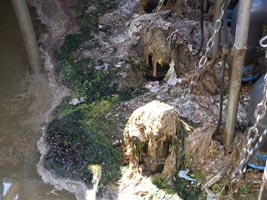 The technical and economic performances of wastewater or septage treatment plants depend on the behaviours of the users i.e. of the subscribers to the public sewered system and the owners of on-site sanitation systems.
The technical and economic performances of wastewater or septage treatment plants depend on the behaviours of the users i.e. of the subscribers to the public sewered system and the owners of on-site sanitation systems.
A few simple rules
The Nègrepelisse plant simplifies the work of the technicians and of the elected representatives, improves the water quality in natural streams, brings back the fish in the Courounets riverfor at least three or four and perhaps ten generations of Nègrepelisse inhabitants.
But it imposes on the users some rules of good behaviour. To start with, the old concept of «total drainage» must be replaced by the awareness that everything thrown into a toilet will reach the treatment plant. Avoid throwing away for example:
- court or roof rain waters: they increase the flow in wastewater collectors, thus the pumping times, and hinder the good functioning of the treatment plant
- wipes, even if the acronym «do not throw to the toilet» does not appear on the packing
- cotton swabs, sanitary towels, etc.
Proscribe washing powders containing phosphates. They contaminate watercourses and Constructed Wetlands do not retain them.
These rules are the citizen contribution to a "green" project, financed by his sanitation bill.
Wipes arrive at the pumping unit and at the treatment plant almost in their initial state (see the picture). They gather on the pumps, form indestructible carpets and create a number of problems for the maintenance staff. Throwing a wipe into a toilet has damaging effects on the life of a fellow worker and on one’s sanitation invoice.
Individual sanitation system
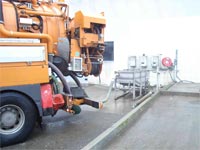 The rules for collective sanitation also apply to individual sanitation because wipes, cloths, plastics… are not degraded in septic tanks and thus end up in the septage treatment plant.
The rules for collective sanitation also apply to individual sanitation because wipes, cloths, plastics… are not degraded in septic tanks and thus end up in the septage treatment plant.
Avoid absolutely to dispose off paints, solvents, hydrocarbons, pesticides… and of chemicals in general in your toilets. One single litre of lead paint or oil is enough to contaminate septage and seriously unsettle the functioning of the plant, with heavy financial impact on plant management and running costs.
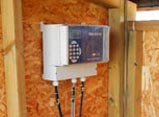
Economic and efficiente
Description of the economical and technical advantages of the wastewater treatment plant.
Read the article
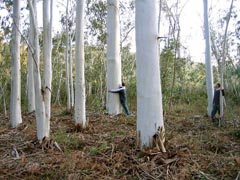
Economic and efficient
Description of the economical and technical advantages of the septage treatment plant.
Read the article